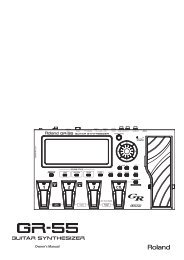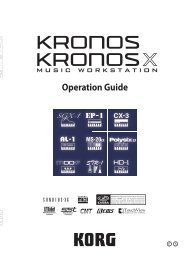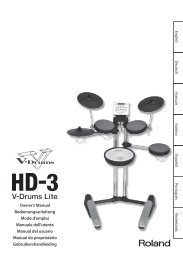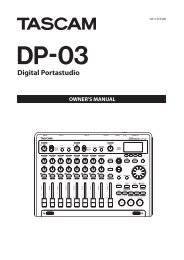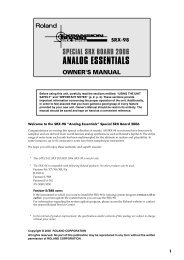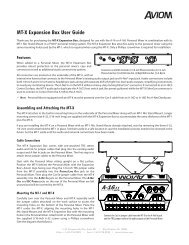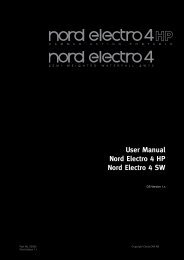Korg Microkorg Owner's Manual - zZounds.com
Korg Microkorg Owner's Manual - zZounds.com
Korg Microkorg Owner's Manual - zZounds.com
You also want an ePaper? Increase the reach of your titles
YUMPU automatically turns print PDFs into web optimized ePapers that Google loves.
3. OSC1 (Oscillator 1) — SYNTH/VOCODER<br />
WAVE<br />
CONTROL 1 CONTROL 2<br />
Triangle Wave ( ):<br />
This is a triangle wave, which has<br />
weaker overtones and a stronger<br />
fundamental than a sawtooth wave<br />
or square wave. It is suitable for<br />
mellow bass sounds.<br />
CONTROL 1 [0...127]:<br />
You can modify the waveform by<br />
adjusting this value.<br />
A setting of 0 will produce a triangle<br />
wave, and a setting of 127 will produce<br />
a waveform with a pitch that<br />
is one octave and a fifth higher.<br />
(➝Figure 3-3)<br />
CONTROL 2 [0...127]:<br />
LFO1 is used to apply wave form<br />
modulation to the waveform specified<br />
by "CONTROL 1." The "CON-<br />
TROL 2" setting specifies the depth<br />
of the modulation produced by<br />
LFO1.<br />
Figure 3-3<br />
0 63 127<br />
Sine Wave ( ):<br />
This is a sine wave. This waveform<br />
contains only the fundamental, and<br />
no overtones at all. It can be used<br />
to create claves or bass drum<br />
sounds. In some synth programs,<br />
oscillator 2 is used to perform cross<br />
modulation* 3-2 (➝Figure 3-4), creating<br />
a more <strong>com</strong>plex overtone structure.<br />
Cross modulation by a sine wave<br />
cannot be applied to a vocoder program.<br />
Since a sine wave contains no<br />
overtones, the filter will not<br />
modify its tone.<br />
Vox Wave ( ):<br />
This simulates a waveform similar<br />
to human vocal cords. Even if the<br />
oscillator pitch is changed, the frequency<br />
spectrum will be maintained,<br />
which makes this effective<br />
when used for vocal-type sounds or<br />
as a vocoder oscillator.<br />
Select HPF or BPF as the filter, and<br />
adjust "Cutoff" to create a vocaltype<br />
sound.<br />
CONTROL 1 [0...127]:<br />
On a synth program, this adjusts the<br />
depth of cross modulation.<br />
On a vocoder program, this modifies<br />
the waveform.<br />
CONTROL 1 [0...127]:<br />
Adjusting this value will modify the<br />
waveform. (➝Figure 3-5)<br />
CONTROL 2 [0...127]:<br />
On a synth program, this adjusts the<br />
depth of additional modulation<br />
applied by LFO1 to the cross modulation<br />
specified by "CONTROL 1."<br />
On a vocoder program, this adjusts<br />
the depth of modulation applied by<br />
LFO1 to the waveform that you selected<br />
by "CONTROL 1."<br />
CONTROL 2 [0...127]:<br />
LFO1 is used to apply modulation<br />
to the waveform specified by<br />
"CONTROL 1." CONTROL 2 sets<br />
the depth of the modulation applied<br />
by LFO1.<br />
Figure 3-4<br />
X-mod Depth + X-mod Depth Mod<br />
OSC2<br />
OSC1<br />
OSC1 Output<br />
Figure 3-5<br />
0 63 127<br />
*3-2: Cross Modulation<br />
This is a type of oscillator modulation<br />
available on analog synthesizers<br />
of the past. Normally, a low-frequency<br />
signal (such as from an LFO)<br />
is used as the modulation source for<br />
an oscillator, but Cross Modulation<br />
lets you use another oscillator as the<br />
modulation source, creating sounds<br />
with a <strong>com</strong>plex overtone structure<br />
that would not normally be produced<br />
otherwise. On the microKORG, you<br />
can use oscillator 2 to apply cross<br />
modulation if a sine wave is selected<br />
for oscillator 1. Gradually raise the<br />
"CONTROL 1" level, and notice how<br />
the sound changes. This can produce<br />
distorted sounds, or sounds with a<br />
metallic character.<br />
You can produce an even wider variety<br />
of effects by adjusting the OSC2<br />
"SEMITONE" or "TUNE" parameters.<br />
You can also achieve interesting results<br />
by applying sync modulation<br />
and cross modulation at the same<br />
time.<br />
19



